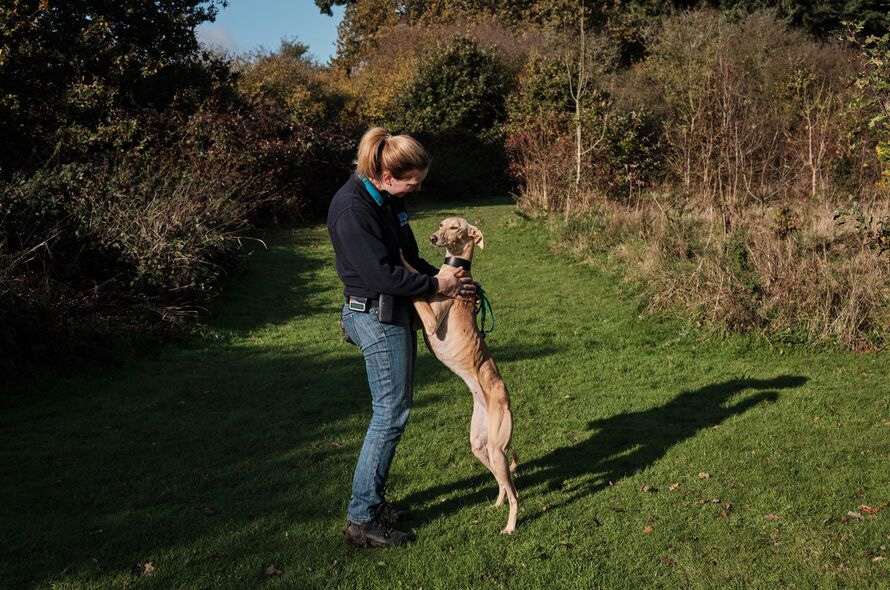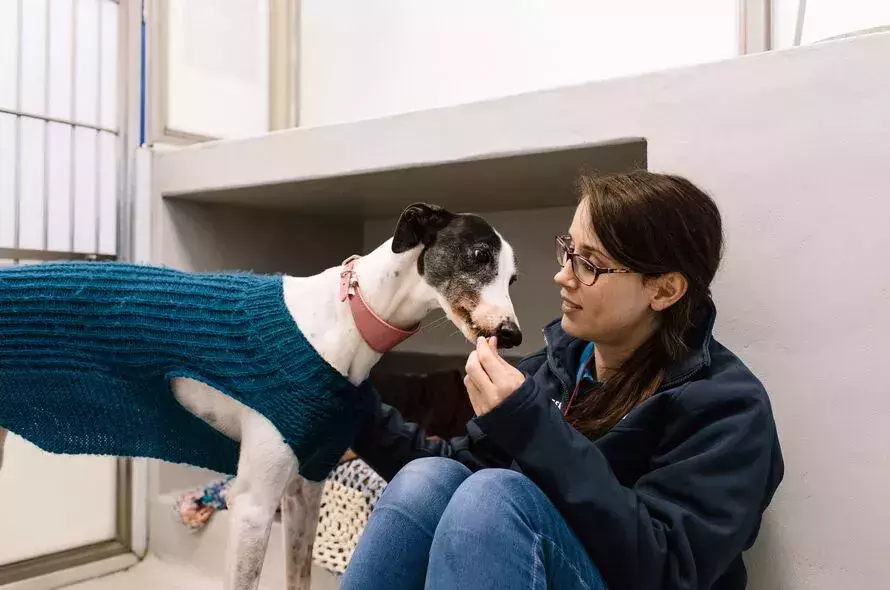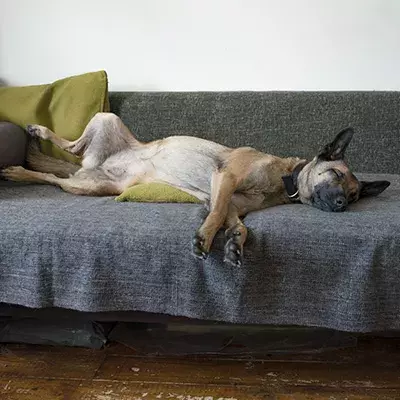Greyhounds are playful, affectionate, and intelligent and can make wonderful, loving pets and welcoming one into your life is the right choice for lots of people. When people think about Greyhounds, they often think of their speed and that they need lots of exercise, but in fact they often prefer short daily walks, with quick bursts of energy, before snuggling back up on the sofa for a nap.

Many ex-racing Greyhounds adapt to life in a new home extremely well, however some may need a bit of extra support so here are some tips on what to consider when bringing an ex-racing Greyhound home for the first time.
Establish a routine
Racing Greyhounds often live a very structured life, following a routine in which they will be fed, go to the toilet and go for walks at a similar time every day. For this reason, they will generally find it easier to settle into their new home if a predictable, structured routine is established from day one. Decide when and where you are going to feed your dog and plan how your walks are going to work around your existing routine. Of course, this may be subject to change over time, but it will help your dog in their first few days at home. Predictability will help reduce any anxieties your dog may have and can help prevent separation related behaviour problems. If you would like to find out more about separation related behaviours and how they can be prevented, take a look at our advice on ‘dealing with stress and separation anxiety’.
Be patient
Each dog is different and will settle into their new home at their own pace, but patience is key. For some retired Greyhounds this may be the first time they have experienced a home environment for a prolonged period of time, so it’s important to be understanding and expect some hiccups in the first few days. Training that often comes fairly easy to other breeds, such as housetraining, may be a little more difficult for a retired Greyhound. Consistency is crucial when working through these early stages of training and investing the time early on will be worthwhile in the long run.
Let them adjust in their own time
You may also find that your Greyhound is slightly distant and will keep to themselves to begin with. Some Greyhounds from a racing background may not have had the opportunity to form relationships with lots of different humans. It is important to be mindful of this and allow your dog to build a relationship with you at their own pace. Greyhounds are a fantastic breed and when given the opportunity, can form strong, long lasting relationships with people. Over time you will begin to see this side to your dog and they often become very loving, even tempered, and affectionate companions.
Getting them used to a home environment
Up until this point, your Greyhound may have spent a lot of their time in a kennel environment, and for some a home environment may be overwhelming at first. Although household items such as washing machines, vacuum cleaners, televisions, stairs and even glass doors may seem normal to us and any dogs you may have owned previously, for some retired Greyhounds these sights, sounds and experiences could take some getting used to. Stairs in particular tend to pose a challenge for Greyhounds, with some not quite being able to master them if they’ve not had experience of them before. Patience is key and you may just find that your dog is happier living their life downstairs with all their essentials readily available to them.
We would suggest exposing your Greyhound to your home slowly. Start off by just setting up one room for them where they have access to all their essentials: a safe space to relax, food, toys and water. Try and find a nice quiet section of the home, where there won’t be a lot of background noise and won’t have lots of people passing through. As you gradually expose your Greyhound to the rest of your home and household items over the first few days, be sure to make the experience as positive as possible. Work at your Greyhound’s pace, paying attention to any body language that may indicate they are uncomfortable.
Use food and toy rewards to engage in positive training that will help create long-lasting positive associations with your home. You may find that as your Greyhound settles in, their curiosity will get the better of them and they may begin to steal household items. Should you need to retrieve an item from your dog, it is essential that you don’t confront them, but instead calmly approach and exchange the item for food or toys. We want your Greyhound to understand that giving up items is a positive experience, preventing any further issues arising. This behaviour often goes away on its own as the novelty of household items starts to wear off.
Sleep Startle in Greyhounds
Racing Greyhounds will have experienced short bursts of intense exercise, followed by long periods of rest and deep sleep. As a result of this routine, they can often be more prone to experiencing sleep startle, which as it suggests, is startled, or frightened behaviour that your dog might display if they are suddenly woken from a deep sleep. You can find out more about sleep startle in our advice piece on the subject and it’s a good idea to think about avoiding this where possible when setting up your home environment for your Greyhound.
Exercising your Greyhound
Greyhounds are often considered to be a breed that requires lots of exercise all the time. While like all breeds, Greyhounds do need sufficient exercise, this belief is not entirely true. In reality, they are often less active than you would expect and will generally prefer to do around two 30-minute walks a day.
However, we do have to consider a Greyhound’s background when deciding exactly how and when we are going to exercise them. Ex-racing Greyhounds will have strong, developed muscles that are accustomed to sprinting and bursts of physical exertion. After this they will then have been rested ready for the next run. This can sometimes mean that dogs with this background have less stamina for long walks and would prefer shorter ones. While your Greyhound settles into their new home and adjusts to a new way of life, we would suggest building up their exercise gradually and seeing what they’re most comfortable with. Start with short frequent walks and increase these slowly over time as their body adjusts to this new exercise regime.
Walking Equipment for your Greyhound
Appropriate walking equipment is essential when exercising your dog, to make sure they are as comfortable as possible and help support their muscles as they adapt. We suggest that all Greyhounds walk on a well-fitted, comfortable harness with a lead attached to a clip on the back. Due to their speed and their instinct to chase, particularly small furry things, (also known as high prey-drive) some Greyhounds might be prone to running off when they spot something they find interesting. Because of this we would advise taking some extra precautions when walking your Greyhound. We would suggest a second clip lead on the collar or a martingale collar, and we would also recommend a muzzle should be worn. Ex-racing Greyhounds will be accustomed to wearing muzzles and will always need to wear one when out walking in public spaces. Muzzles in this context simply act as a safeguarding measure, as your dog’s prey drive is likely to be triggered by small animals, cats, and possibly even smaller dogs. In the event your Greyhound does show any chase behaviour around other animals, the muzzle will help keep them safe and prevent any injury.
Letting your Greyhound Run Safely
Greyhounds will need the opportunity to run on occasion. Due to the nature of their racing history, if they have one, we advise that they are not let off lead in public places to protect not only other animals but also themselves as they may run into danger. There are secure dog walking fields available that allow Greyhound owners to exercise their dogs off lead safely. You could try using a long line lead, which will give your Greyhound more freedom but still allow you to be in control should you need to be. If you’re using a long line with a Greyhound, it must be clipped onto the harness at all times and not the collar, to avoid any sudden tension around the neck if they reach the end of the lead. We also strongly advise against using any retractable leads with your Greyhound. Greyhounds can reach incredible speeds when sprinting and retractable leads are often difficult to grab or stop quickly, without causing injury to your hands or possibly the dog.
Recognising ‘Prey Drive’ or ‘Chase Drive’
Prey drive, or the instinct to chase, is something that all dogs have, but some dogs experience it and act on it more than others. Ex-racing Greyhounds will have been brought up in an environment where their prey drive has been actively encouraged and rewarded, which will understandably mean they are more likely to display them. You are most likely to see this behaviour around smaller dogs, cats and wildlife and being able to identify it will help prevent your Greyhound running off on your walks. When a Greyhound is engaging in prey drive, they will often be quiet, controlled and will not growl or bark. Instead, you are likely to see changes in their body language that might include stalking, staring, muscle tension, lip licking, teeth chattering, trembling, their ears might be pricked up, and they will probably be reluctant to break focus. Should you notice these body language changes from your dog when out walking, try to create distance between yourself and whatever it may be they are fixated on and move away.
Socialising your Greyhound with Other Dogs
During their racing days, Greyhounds will often only interact with other Greyhounds and vary rarely see dogs of other breeds. Because of this, it’s understandable that for a Greyhound walking in a public park potentially for the first time, the presence of other dogs of different shapes and sizes could be overwhelming. Greyhounds are notorious for their sociability however, occasionally they do struggle to read and understand the play styles of more energetic breeds due to lack of experience. Equally, other dogs are not always understanding of a Greyhounds desire to engage in chase games and may find interactions difficult to begin with. In a similar way to how you have slowly introduced your Greyhound to their new surroundings, we need to take the same approach with other dogs. Start off gradually, keeping interactions short and, if possible, meeting with friends and family who have polite, sociable, calm dogs. Sighthounds, such as Greyhounds and Lurchers generally communicate much more effectively and clearly with dogs of a similar breed type, so encouraging calm, polite interactions with other Greyhounds or Lurchers can really help build your dog’s confidence.

